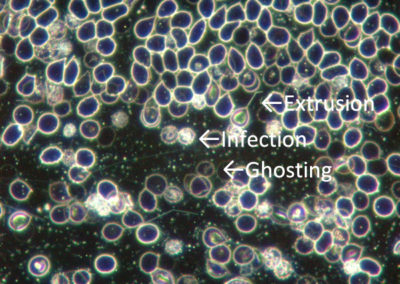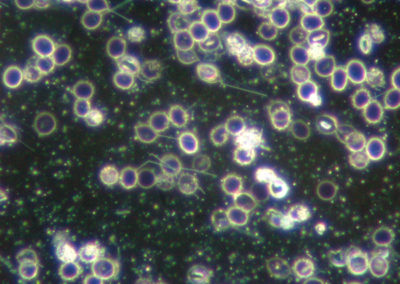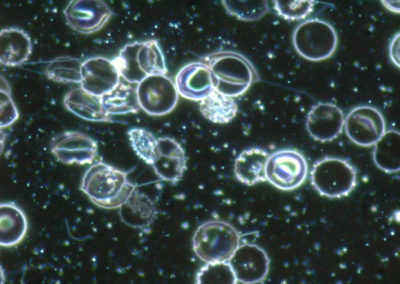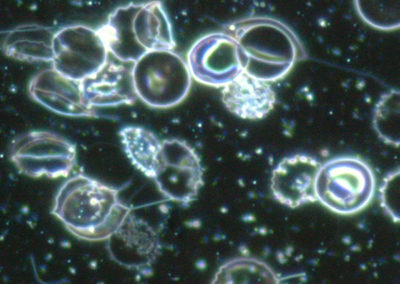
The Vision & Ways to Help
Since the Institute was conceived, a few people have made donations in lump sums or monthly commitments. In the very beginning, all the funds went to the project in Ecuador. Though I no longer have any connection with what is going on there, it appears that the clinic is functioning.
More recently, the donations have supported public outreach: development of an educational platform which will go live next year and publication of numerous pdfs and e-books. The next step is to create an actual place for the work, and the top priority at this time is better microscope equipment. The gift of a camera was not exactly a Trojan horse, but it is completely below the standard needed for professional presentations and hardly even adequate for basic clinical use. Also, a new microscope is needed. On the last trip, I used a very old and cumbersome Lomo so I am looking at something now with far better optics. Also the working environment needs to be both more sterile as well as shielded for Wi-Fi as there is no doubt whatsoever that the router in the adjacent room was affecting our studies.
The financial goal for improving the equipment and working environment is $12,000.
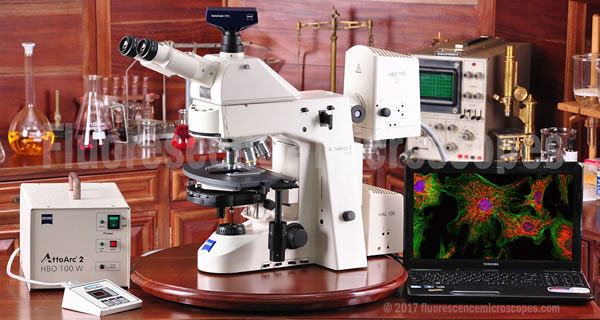
An Example of Proper Scope
The Wi-Fi story has an upside and a downside because the vulnerability of patients to Wi-Fi was very evident, but protection is clearly essential to full recovery so exposure has to be minimized.
Last weekend, I went over all the images from the study done years ago with just cell phones, no router. There was significant attrition and recovery took about 14 hours after the exposure ended. Realistically, this means that patients in seriously weakened condition should be in a more protective environment and their use of mobile devices needs to be limited or eliminated.
Personally, I do not use any Wi-Fi devices at home and none of my appliances are modern. I do not have a router or microwave oven nor any “smart” appliances though there is a smart meter, but it is shielded.
Making the argument for reducing the wear and tear of modern technology is very difficult online. There are many voices and probably a tendency to tune out what is unwelcome. Live with patients, the Wi-Fi issue is easily demonstrated so whether or not it leads to more safety depends on the measures patients are willing to take in the name of safety. There are conveniences to weigh against safety considerations and also habits to overcome.
That said, in terms of a research environment, the Wi-Fi intrusions need to be kept to a minimum. Interestingly, we tested not just the area around the router but all the exterior areas where unsightly overhead wires were seen. The results were not quite as expected. Based on the Becker studies, I anticipated much higher readings where there were many wires. In actuality, this was not the case. My tentative explanation is that the level of electromagnetic pollution mentioned in studies done 25 or more years ago was drastically lower than what Wi-Fi intrusion is today. The significance is obviously something to take seriously, especially with 5G on the horizon.
LOCATION OR RELOCATION
The quest for the ideal location has been underway for some time. The factors influencing the various options and considerations are numerous and obviously important. The first issue has always been the ease of creating what we want in a foreign country. In response to inquiries about remaining in the U.S., my opinion is that it is not possible to do the work intended anywhere in the U.S. There may be a way, but, as of this writing, no one has found it.
The subjects that come up under the preliminary questions include all sorts of governmental issues such as the position on indigenous and natural healing, import and export regulations, visas, investment incentives or lack thereof, and stability of the government.
To give this a context, we can use Ecuador as an example. It provides constitutional protection for indigenous medicine, but then the definition of indigenous becomes important. Is the intent consistent with the Pachamama provisions designed to protect Mother Nature and the environment, or are they referring specifically to Amazonian and Quechua traditions of healing? Most lawyers with whom we spoke believed that the law only offered protection to indigenous Ecuadorian medicine and not to other enthnobotanical systems of healing.
Visas are relatively easy to obtain in Ecuador, but import-export of herbs was another matter, and advisors kept pointing us to Paraguay as a simpler and more cost-effective solution. Then, we come to the issue of stability and anyone watching the news knows that the government under Rafael Correa was very different from that of his successor, Lenin Moreno. The purpose in mentioning this is that Latin America has a history of political instability, but we need only look at the EU to see that public demonstrations and support or lack thereof for policies can change. There is no incentive however to take the risks associated with unpredictability unless one just happens to have a passion for gambling.
After factoring in political stability, we need to look at geological issues. When we first arrived in Ecuador, Cotopaxi was active and after moving to Baños de Agua Santa, Tungurahua roared. In addition, there was one very major and several minor earthquakes. Elsewhere, there might be tidal waves and hurricanes, but if we fall in love with a beautiful vista, we have to be sure it will not be wiped out by some act of Nature. In short, the risk of volcanic eruptions, earthquakes, violent storms, and drought should be as close to zero as possible.
Next, the location should be accessible by air and within an hour of an international airport. It should be above the level of tropical disease risks, i.e., above the mosquito zone which may mean at least 5000 to 7500 feet in elevation. Within proximity of the chosen location, there should be highly skilled biological dentists with modern equipment and up-to-date training in safe removal of amalgam fillings and repair of shoddy dental work with biocompatible materials.
Then, we come to agriculture. If the country has a strong position with respect to resisting GMO incursions and protecting traditional agriculture, that is also a plus. If there are no chemtrails or nuclear reactors, those are additional reasons for moving up on the list.
In sum, there are many factors to consider, and one that has been repeatedly reiterated by patients as well as people wanting to attend seminars and retreats, is that the distance should be considered. Distance is obviously relative to the starting point. Believe it or not, the U.S. is not the center of the world so we looked at distance in terms of Europe and Asia, not just North America.
The quest for a permanent location is not over. At the moment, Mexico is at the top of the list, but this could change. Ecuador is off the table at this time despite how promising it looked a few years ago. Many South American countries had been considered, but as we see now, the turmoil in Venezuela is impacting neighboring countries, but it could be Argentina one day, Venezuela the next, and then who knows which country. In the meantime, your suggestions are welcome.
NETWORKS
It is possible to affiliate with an existing small practice or even major tourist attraction that offers spa treatments and detoxification protocols providing the standard is impeccable. It is also possible to work with existing organic farms, botanical gardens, medicinal herb laboratories, or even with medical anthropological studies. The more connection there is to the local community, the better it is for all concerned, but the Institute itself will be independent. It will direct the studies and support dissemination of information via online publications and webcasting as well as through hosting seminars, courses, translations, and publishing both digital and printed materials. It will have a graphics team for visual productions and a holistic health team for research and teaching, but it can collaborate with local health care professionals, indigenous healers, botanists, herbal medicine producers, spas and resorts, ecological tourist adventures, and other institutions.
For instance, in Ecuador, I was very much looking forward to a connection with Yachay University in Ecuador. It was announced in 2013 as one of four universities dedicated to cutting edge research, but it did not get off the ground. To date, there have not been any graduates though some version of it may have survived. I believe the world is in a state of change so networking with progressive and innovative people and projects is a high priority.
That said, for reasons that perhaps make more sense to me than some others, having one or more doctors trained in Ayurvedic or Siddha Medicine is important so I am exploring the potential for meaningful collaboration.
THE FACILITY ITSELF
The first part of the Institute to be created must perforce be the microscope room, but it has to be quickly followed by the herb processing area and apothecary. These, in turn, must link to a juice bar and kitchen that is capable of providing organic meals throughout the day.
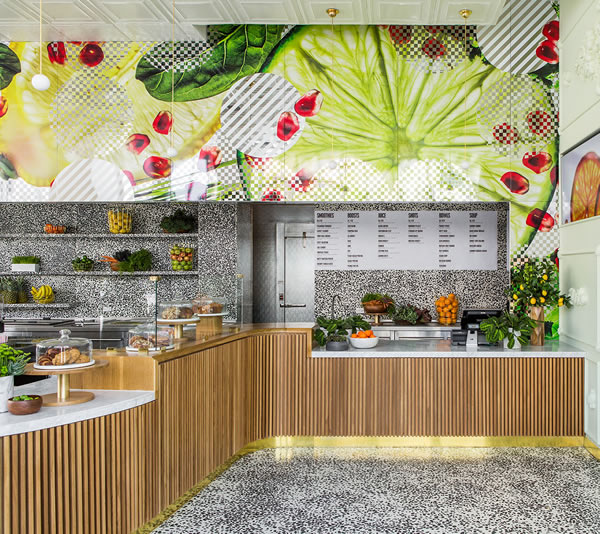
For Illustrative Purposes Only
In practical terms, what this means is that “others” can offer the accommodations and food services as part of an existing operation or a new development. They can do this in any way that suits them. One can start with a small boutique hotel, a dude ranch, or an eco village. There can be one restaurant or severa so long as what is served is organic or biodynamic, GMO-free, and nutritious. Ideally, the food service providers should also be able to offer what is needed for those undergoing detoxification, immune enhancing, or special treatments for health conditions.
Examination and treatment rooms can be provided by the same organizations that offer the accommodations and meals or they can be under a separate umbrella that is entirely clinical in scope. However, since the purpose of the Institute is not to operate a either a hotel or clinic, the forward motion of the Institute will focus on investigations of health conditions and herbs using a combination of health studies, ethnobotanical lore and publications, darkfield microscopy, and psychospiritual approaches to understanding the nature of human suffering.
The goal is always to put the emphasis on truth and clinical findings rather than consensus. There will be opportunities for collaboration with other professionals as well as internship possibilities. In addition, there will be a major emphasis on education using online options for teaching and publishing. Therefore, after the creation of the microscopy center and apothecary, the next step will be the graphics, video, translating, and publishing room. This will operate under the name of Bioethika Press.
In the third phase, classes and seminars will be live. So, there will be a small “theater” with seating for video streaming, seminars, and conferences.
PRIORITIES
To be honest, it took a while to recover from the shock of the destruction of all the work that had gone into the Ecuador project. I have not said much, but catching a second wind was not at all easy.
For now, I want to concentrate on the invisible epidemics and share as we go along. I am working with someone to assemble the materials into pdf format and would, of course, be grateful for suggestions and help with editing.
What I did last weekend was to comb thousands of photomicrographs from 2003-2005, before the Lyme epidemic was fully recognized in Europe, to see if any of the patients seen might also have been Lyme-infected. As expected, evidence was found and it does help with the interpretation of what was seen in Mexico last month.
It will take time to complete this study. Meanwhile, I am working on a manual for managing hemoloytic conditions such as babesia and malaria. It includes background material, succinct in writing style, and protocols as well as recipes for juicing and eating during different phases of the parasite cycle.
In addition, some courses are ready to launch and we hope to have a stable launch in early 2020. I have completed all the teaching materials for about 20 webinars, each with PowerPoint presentations, e-books, and hand-outs. I think I can handle both the research and webinars simultaneously once moved to a permanent location.
Finally, we have our eyes on a property near San Miguel de Allende that would make an incredible location for medicinal herb and food gardens, treatment, and even time sharing or retirement possibilities for those who want to rely on holistic health measures.
Dr. Ingrid Naiman
22 October 2019
Updated 11 December 2019
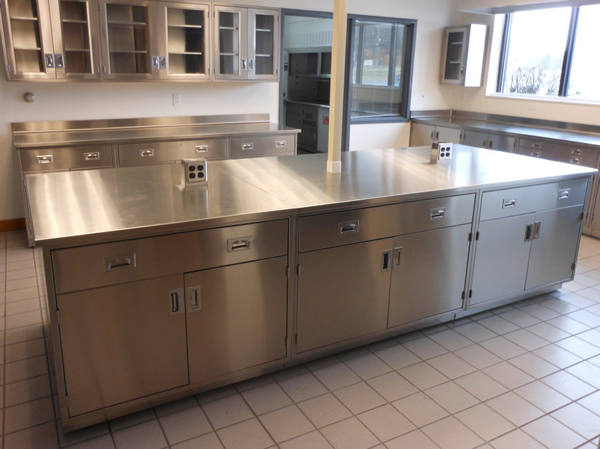
Concept for Herb Processing and Formulating Space
Privacy Policy || Report Technical Problems || Permission to Quote || Job Opportunities
Copyright Dr. Ingrid Naiman @ 2014-2020. All Rights Reserved.
For permission to quote, please contact the Institute for Invisible Epidemics.
Poulsbo, Washington, USA.

